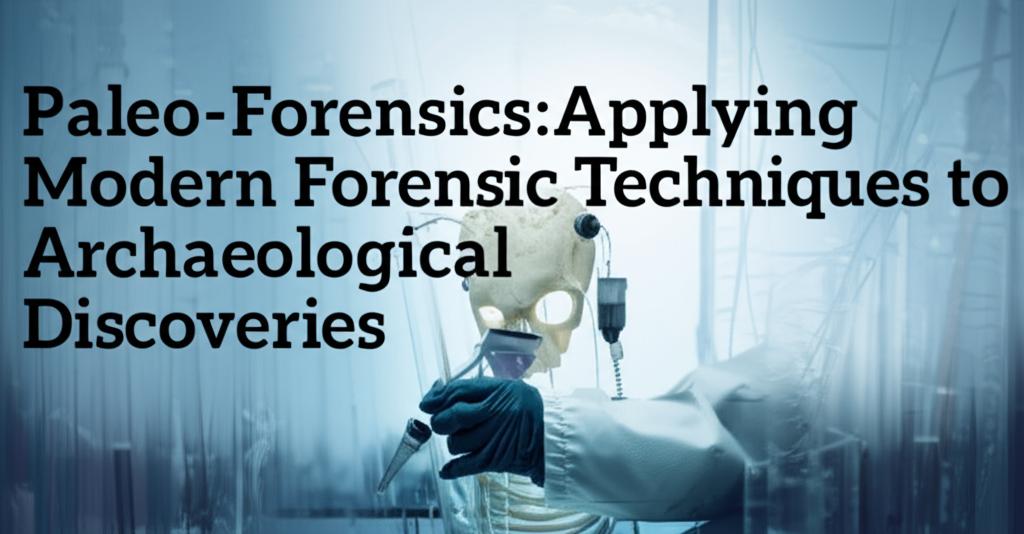Paleo-forensics is bridging the gap between the past and the present by using modern scientific techniques to analyze archaeological discoveries. This interdisciplinary field is significantly enhancing our understanding of ancient civilizations, human evolution, and even specific historical events.
Key Modern Forensic Techniques and Their Applications in Archaeology:- DNA Analysis (Paleogenomics): This is arguably one of the most revolutionary techniques.
Extracting and Sequencing Ancient DNA (aDNA): Despite challenges like degradation and contamination, scientists can now extract and sequence DNA from ancient bones, teeth, and even sediments. Advances in Next-Generation Sequencing (NGS) and specialized extraction kits have made this possible.
Unveiling Ancestry and Migrations: aDNA analysis helps trace lineage, understand ancient population movements, admixture events between different groups, and reconstruct overall human evolutionary history.
Identifying Individuals and Relationships: Similar to modern forensics, aDNA can identify specific individuals from the past and uncover familial relationships. For instance, it was instrumental in confirming the identity of King Richard III.
Understanding Ancient Diseases: Researchers can identify pathogens present in ancient remains, offering insights into the diseases our ancestors faced and how they evolved.
Addressing Contamination: New methods are being developed to distinguish ancient DNA from modern contamination, which has historically been a major hurdle.
- Advanced Imaging Techniques:
CT Scanning and Digital Microscopy: Computed Tomography (CT) scans and high-powered digital microscopy allow for detailed, non-destructive examination of remains and artifacts, providing insights into injuries, pathologies, and the overall condition of bones. They can reveal perimortem injuries like fractures or cuts, helping to determine the cause of death in ancient cases.
3D Imaging and Facial Reconstruction: 3D scanning technology creates highly accurate digital models of skeletal remains and artifacts. This allows for precise facial reconstructions, helping to visualize individuals from the past and aiding in public engagement and sometimes even identification.
Near-Infrared Hyperspectral Imaging (HSI): This innovative, non-destructive technique can quantify and map the presence of collagen in archaeological bones. Collagen is essential for radiocarbon dating, so HSI helps select the best samples (or parts of samples) for dating, minimizing the destruction of valuable and rare bone material.
Ground-Penetrating Radar (GPR): GPR is a non-invasive tool used to detect buried remains, structures (like graves, walls, or foundations), and objects without the need for excavation. This helps in planning excavations and understanding site layouts.
- Isotope Analysis:
Dietary Reconstruction: Analyzing the isotopic composition of elements like carbon and nitrogen in human or animal remains can reveal dietary habits (e.g., herbivorous, carnivorous, marine-based).
* Geographic Origin and Migration: Strontium and oxygen isotope analysis can provide information about an individual's geographic origin and track migration patterns, as certain isotopic signatures are associated with specific regions.
- Chemical Residue Analysis: This technique analyzes microscopic residues on artifacts like pottery or stone tools to determine what substances they came into contact with. This helps archaeologists understand how objects were used, what they contained, or what materials were processed with them.
- Radiocarbon Dating: While a long-standing archaeological tool, advancements continue to refine its accuracy. When applied in conjunction with other forensic techniques, it helps to accurately date remains and contextualize findings. Forensic carbon-14 dating can even be used for more recent forensic cases due to distinct fluctuations in atmospheric radiocarbon over the last 50 years.
- Paleomicrobiology: The study of ancient microbes from sources like coprolites (fossilized feces) can reveal information about paleo diets, cultural differences, and the gut microbiome of ancient populations. Understanding DNA degradation patterns in bacteria could also help determine the postmortem interval (PMI) in ancient contexts.
- Fingerprint Analysis: Preserved fingerprints on ceramics, created when a potter shaped the clay, can be analyzed. This technique, one of the older forensic methods, can help in understanding site timelines and potentially identifying individual artisans.
- Dental Microwear Analysis: Examining the microscopic wear patterns on teeth can provide insights into an individual's diet and food processing techniques.
The strength of paleo-forensics lies in its multidisciplinary approach. By combining archaeological excavation methods with techniques from forensic anthropology, genetics, chemistry, and imaging sciences, researchers can reconstruct past events and lifestyles with greater accuracy and detail. This can range from understanding the health and diet of ancient populations to solving "cold cases" that are centuries or even millennia old, like determining the cause of death from skeletal trauma.
Recent Advancements and Future Directions:- Enhanced DNA Recovery: Ongoing research focuses on improving methods to extract usable DNA from highly degraded or scarce samples, including those from challenging environments like hot and humid climates. Single-molecule sequencing (SMS) techniques are emerging to improve data quality from degraded aDNA without PCR amplification.
- Bioinformatics: Sophisticated bioinformatics tools are crucial for reconstructing and analyzing ancient genomes, even when closely related reference genomes are absent.
- Paleoimaging: This specialized area continues to see advancements in imaging technologies and their applications to cultural artifacts, human remains, and bioarchaeological research, offering non-destructive ways to uncover hidden details.
- Integrating Multiple Lines of Evidence: The future of paleo-forensics will likely involve more integrated analyses, where genetic data, isotopic information, skeletal analysis, and archaeological context are combined to create more holistic narratives of the past.
- "One Paleopathology": This emerging concept promotes a holistic, interdisciplinary approach to understanding health through deep time, looking at how human, animal, and environmental health are interconnected, using insights from past diseases and climate changes to inform present-day health strategies.
By applying the rigorous methodologies of modern forensic science to ancient discoveries, paleo-forensics not only solves ancient mysteries but also provides invaluable context for human history, evolution, and our relationship with the environment over millennia.

